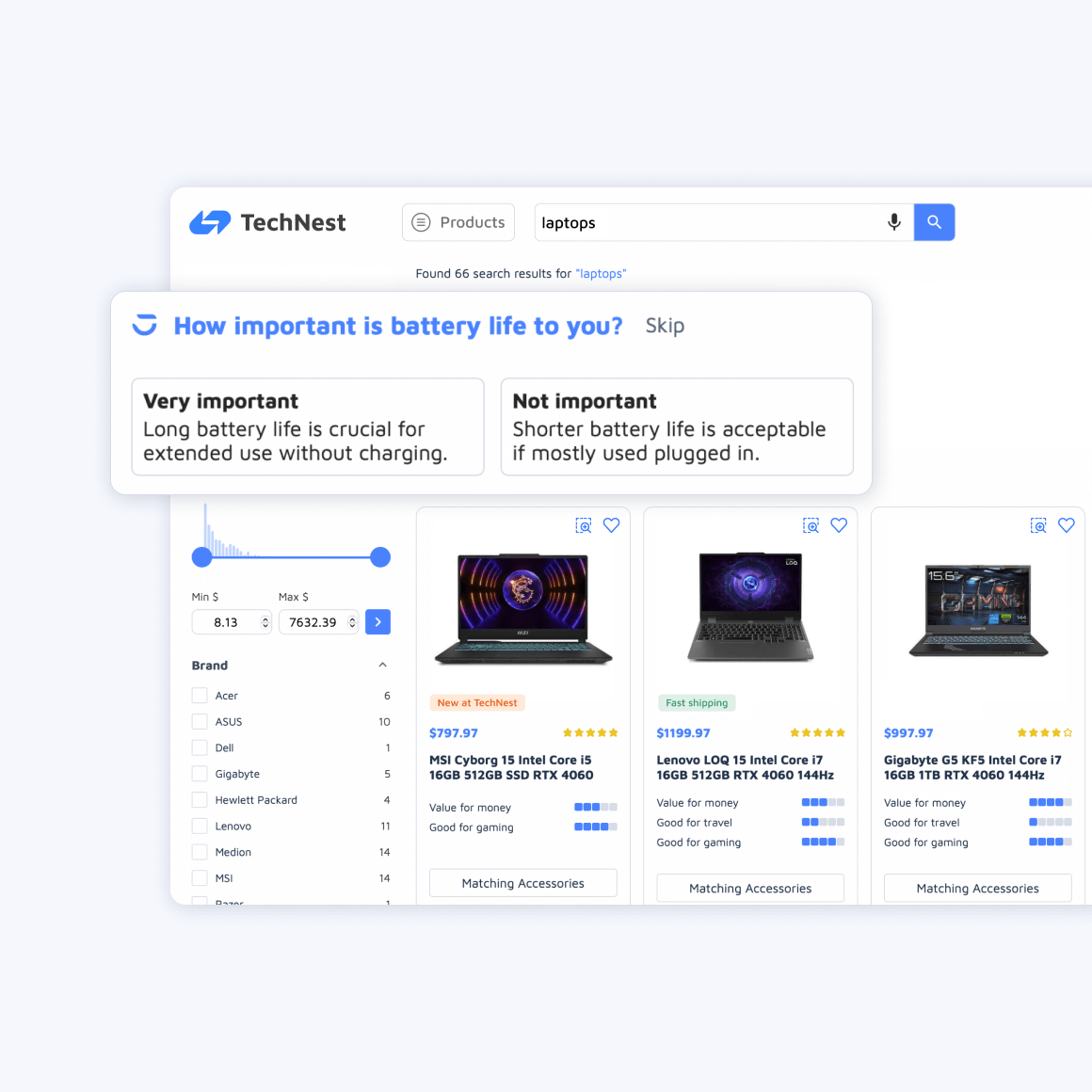Turn queries into conversions automatically, intelligently, and at scale
Search is how digital commerce begins.
In fact, 93% of online buying starts with a search box, but most end in frustration. Why? Because the typical search experience hasn’t evolved with user expectations. It’s still designed around traditional keyword search—a method that’s outdated for how people actually ask questions.
If they can’t find it, they can’t buy it
Today’s shoppers use complex queries, seek clarification, and expect the experience to feel as seamless as a conversation with a real person. But most ecommerce search engines still treat every user query like a static string of keywords, not a real-time dialogue.
- 75% of shoppers abandon sites when they get irrelevant or inaccurate search results
- Brands lose revenue every second to ineffective search experiences
- Customers don’t convert—not because the product isn’t right, but because the search failed
For ecommerce brands looking to connect customer needs with the right products, this is where conversational site search platforms like Zoovu come in.
What is conversational search?
Conversational search uses natural language processing (NLP) and artificial intelligence (AI) to simulate a typical sales interaction. Instead of relying on exact-match keywords, it interprets intent and guides users toward relevant results through a sequence of adaptive, intelligent questions.
Think about how people interact with Google Assistant, Alexa, or digital voice assistants. They speak or type naturally, and expect the system to understand them—even if they’re vague.
That’s the core promise of conversational search: Search that thinks like your customer. Search that talks back—and leads forward.
The conversational search experience in action
Imagine searching for a laptop on a site. Instead of typing “lightweight gaming laptop 16GB RAM,” you start with:
“I need a laptop for photo editing and gaming.”
Rather than dumping you into a sea of SKUs, a conversational search engine replies:
- “Do you need something portable or more powerful for desktop use?”
- “How important is screen size for your work?”
- “Are you editing photos professionally or casually?”
This conversational capability mirrors human conversation. It mimics the helpful back-and-forth of a customer service agent who clarifies your needs and walks you toward a confident choice.
It’s not simply better UX—it’s a smarter way to guide users who ask context-sensitive questions, handle nuance, and guide complex decision-making.
Conversational search solves for four types of shoppers
Ecommerce traffic is diverse. Your visitors include:
- Browsers (50–70%): Visual explorers clicking around
- Searchers (25–35%): Using direct, goal-oriented search queries
- Followers (5–15%): Arriving from social links, email, or affiliate traffic
- Hunters (2–4%): Returning to repurchase or compare favorites
Most ecommerce search platforms are built for Hunters. But Browsers, Searchers, and Followers make up 95% of your visitors. They don’t always know what they want. They need to be led.
Conversational search functionality works across these journeys by:
- Surfacing relevant content quickly
- Asking targeted follow-up questions
- Learning from previous interactions
- Adapting based on conversation history
This means better user experience, faster decision-making, and higher conversion rates.
Why traditional search fails in 2025
Ecommerce search problems fall into a few common traps:
- Choice overload
A simple headphone query can return 40,000+ results. Even filtered, with a faceted search tool, users face thousands of similar items. This search experience is overwhelming. - Fear of Better Options (FOBO)
Even after narrowing down, shoppers hesitate:
“What if there’s a better product I didn’t see?”
This effort-intensive search cycle leads to paralysis and cart abandonment. - Lack of context
Most engines can’t recall the initial question, adjust for the current conversation, or bridge from one session to the next. There’s no memory of the previous step, no sense of flow.
Conversational search solves these gaps
Conversational site search tools, like Zoovu, address these core issues:
- They reduce choice overload by narrowing options using intent recognition
- They eliminate FOBO with data-enhanced customer experiences and clear, guided comparisons
- They use progressive conversation flows to remember the user’s questions and ask smarter clarification requests
This isn’t just about shopping.
It’s about building trust.
How conversational search works under the hood with Zoovu
The best conversational search experiences do more than simulate dialogue — they deliver real understanding, personalization, and performance. Here’s how Zoovu powers next-generation search that doesn’t just keep up — it converts.
1. Core search API
Zoovu’s AI-powered search engine supports both standard queries and rich, contextual conversations. Whether a shopper types in “lightweight waterproof jacket” or answers a few guided questions about hiking plans, Zoovu dynamically understands the intent and serves up tailored results — instantly.
- Supports multi-format queries (broad, specific, feature-based, and use-case driven)
- Fast performance with <1s page loads and dynamic, embedded discovery tools
2. Natural Language Processing (NLP)
At the heart of Zoovu’s conversational layer is robust NLP. It interprets customer inputs — even with misspellings, synonyms, or subjective phrases like “affordable” — to uncover what shoppers actually want.
- Understands intent behind queries like “TV for gaming” vs. “TV for games”
- Handles long-tail and conversational prompts, enabling flexible discovery
| “TV for gaming” | “TV for games” |
|---|---|
|
Likely intent: A user wants a TV optimized for playing video games. |
Likely intent: A TV for watching televised sports or game shows (e.g., “football games”) |
What they care about:
|
What they might care about:
|
3. Contextual understanding
Zoovu doesn’t treat each interaction as isolated. Instead, it draws on session data, behavioral cues, and prior selections to continuously adapt and refine recommendations.
- Context-aware systems learn from user interactions across search, filters, and guided selling experiences.
- Anticipates follow-up needs and delivers next-best actions in real time.
4. Content curation and data enrichment
Zoovu converts raw product data into discovery-ready content. Through automated structuring and enrichment, the platform turns complex specs into conversationally accessible attributes.
- Translates PDFs, catalogs, and spreadsheets into structured, searchable formats.
- Enriches product data with use-case, persona, and feature metadata for higher relevancy.
This is what powers Zoovu’s ability to return products that match user needs, not just what they typed.
5. Conversational platform architecture
Zoovu’s platform is built for flexibility. Brands can launch tailored conversational experiences using pre-configured templates or customize flows via a no-code interface.
- Drag-and-drop interface and WYSIWYG builder to deploy assistants in days — no dev team required.
- Built to scale across channels, languages, and partners.
The connective tissue: From data to decisions
Zoovu isn’t a bolt-on search plugin — it’s the connective layer between your product data, business rules, and buyer behavior. By unifying these elements through AI and intuitive interfaces, Zoovu transforms the search bar into a revenue-driving discovery engine.
- Reduces FOBO (Fear of Better Options) with guided, confidence-building recommendations
- Enables search-to-purchase journeys that feel personal, frictionless, and fast.
What conversational search reveals behind the scenes
Beyond user experience, conversational search provides better data for teams:
- Product preferences by region, language, or source
- Drop-off rates based on specific questions or filters
- Channel-specific behavior—e.g., Google Ads visitors converting 4x more than Amazon traffic
- Insights on which products succeed with which buyer profiles
This turns your search engine into a real-time analytics engine—fueling R&D, content teams, and marketing with insights that a static chatbot or default search pipeline simply can’t deliver.
Does conversational search impact SEO?
Yes.
When search experiences are personalized and built around contextual understanding, they improve:
- On-site engagement
- Dwell time
- Click-through to PDPs
- Reduced bounce rate
This feeds into modern SEO signals for search engines, as Google and others evolve to reward UX and content that meets actual user intent.
How to choose the right platform
Not every solution labeled “conversational” delivers on the promise. Look for platforms that support:
- Conversational search tools with multi-turn dialog capability
- Full integration of voice search and mobile-optimized workflows
- Support for extensive dialog across long buying cycles
- Built-in analytics and insights
- Generative AI and large model support
- Fast time-to-value with sample API request placement and easy deployment
Zoovu, for example, offers a full conversational search workflow template, complete with behavioral data capture, flexible UI tools, and proven results.
Closing thought
Search should feel like a conversation—not a challenge. It should offer answers, not more decisions. It should work like your best in-store associate—only faster, and always on.
Conversational search is how ecommerce catches up with real customer expectations.
The tools exist. The buyers are ready. The gap is yours to close.
See how Zoovu closes the gap and book your demo today.


